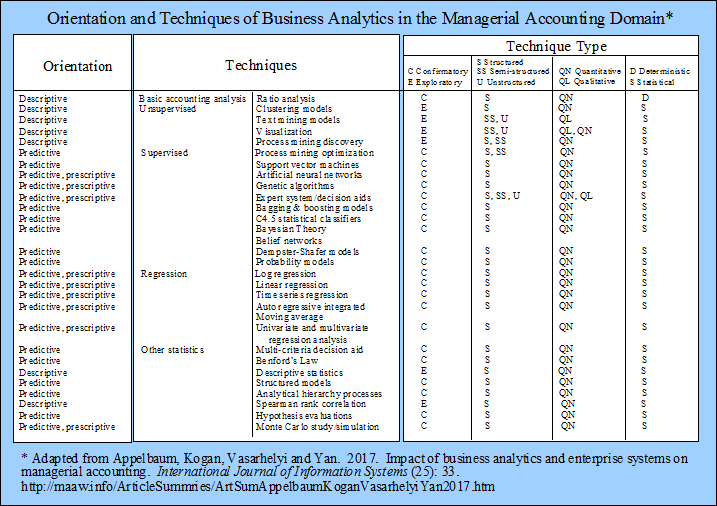
Summary by James R. Martin, Ph.D., CMA
Professor Emeritus, University of South Florida
Data Mining and Big Data
Main | Technology Related Main
Although the scope of managerial accounting has expanded over recent years, management accountants have not fully utilized all the functions of enterprise systems, including descriptive, predictive, and prescriptive data analytics, and big data from internal and external sources. The purpose of this paper is to discuss the potential advantages of combining enterprise systems, big data, and data analytics into managerial accounting, and to provide a management accounting data analytics framework that combines these concepts and techniques using the four perspectives of the balanced scorecard.
The Changing Role of the Managerial Accountant
The traditional role of management accountants was focused on financially oriented decisions, budgetary control, and product profitability. More recently, the focus of management accounting has shifted to drivers of financial performance, channel profitability, enterprise performance management, predictive accounting, and business analytics. Management accountants have used enterprise systems as a tool for report generation, but have neglected its potential for providing more forward-looking (predictive) information.
Big Data and Business Analytics
Big data refers to large unstructured data sets originating from traditional transactions as well as unstructured sources such as emails, audio files, internet click streams, social media, and news media. Big data is characterized by immense volume, high velocity, broad variety, and uncertain veracity. On the other hand, traditional accounting data is structured, e.g., orders, sales, time sheets, inventory, and shipments. To be useful, data needs to be of high quality, i.e., complete, precise, valid, accurate, relevant, consistent and timely.
Business analytics can be viewed from three dimensions: domain, orientation, and techniques. Domain refers to the environment where analytic techniques will be applied, e.g., business management, auditing, healthcare. Orientation refers to the purpose of the analytics, i.e., descriptive (what happened?), predictive (what could happen?), or prescriptive (what should happen?). Analytic techniques refers to the various analytical processes that can be applied to the available data including qualitative or quantitative, deterministic or statistical, or based on structured, semi-structured, or unstructured data as illustrated in the graphic below.

Enterprise Systems with Big Data and Business Analytics
There are a number of challenges related to enterprise systems, big data and business analytics that include the following:
1. Complex data extracts, data fluctuations, duplications, security weaknesses, and multiple analytical tools and languages (SAS, SAP, R, SQL, Python, SPSS, and Tableau).
2. Traditional analytical and machine learning methods may create problems in a big data enterprise system. The analytic model and the associated data will need to be transposed into the enterprise system format, typically SQL. Some current enterprise systems now provide the capability for cleaning, normalizing, and formatting the data prior to extraction as indicated below.
Balanced Scorecard Theory
This section includes a description of balanced scorecard theory and methodology. The authors' framework includes the balanced scorecard as a way to integrate data analytics into enterprise systems for the purpose of measuring corporate performance. See MAAW's Balanced Scorecard section for many related article summaries, as well as summaries of books about the balanced scorecard by Kapan and Norton.
Managerial Accounting Data Analytics Framework or MADA
In the MADA framework, management accounting is separated into three categories: Cost accounting, performance measurement, and planning and decision making. Cost accounting is focused on internal data to generate financial reports. Performance measurement is also mainly focused on internal data, although external data may be used for benchmarking. Planning and decision making focuses on the internal data generated by cost accounting and performance measurement, as well as related external data that is typically unstructured. Data analytics is applicable to all three categories: Descriptive analytic tools are useful for cost accounting, both descriptive and predictive tools are used for performance measurement, and all three tools, descriptive, predictive, and prescriptive are utilized for planning and decision making.
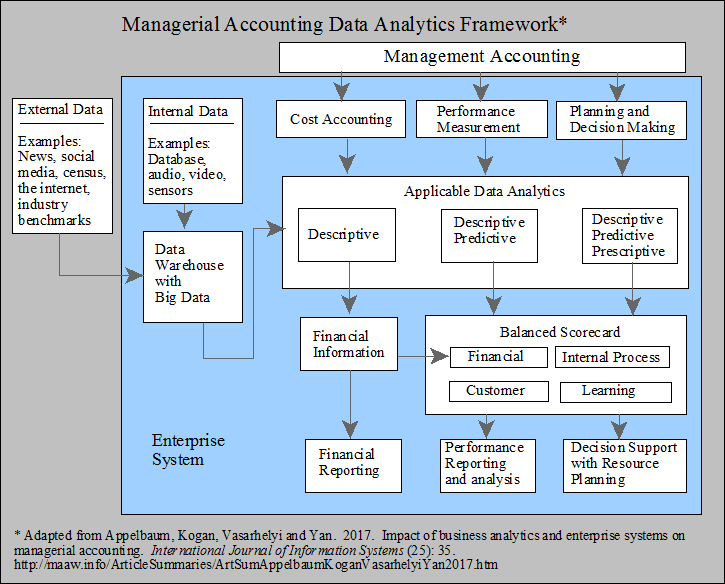
Data Analytics and the Balanced Scorecard Perspectives
Descriptive analytic techniques are used to provide information from the balanced scorecard's financial perspective, e.g., ratio analysis to compare return on investment with historical data. Predictive analytic algorithms are also useful in estimating future financial performance. These results can then be utilized to apply prescriptive analytics to generate recommendations for optimal solutions based on estimated outcomes.
All three types of data analytics are applicable to the customer's perspective, where the customer is concerned with time, quality, performance, service, and cost. For example, ratio analysis can be used to measure defect rates, product returns, and warranty claims. Predictive analytic tools are also useful for generating estimates related to all four concerns of the customer, e.g., tools such as genetic algorithms, log regression, time series regression, structural models, analytical hierarchy processes and Monte Carlo simulations. Prescriptive analytic tools can then be used to estimate optimal solutions related to time, quality, and service versus cost.
From the internal process perspective, the condition of internal processes (e.g., cycle time, quality, employee skills, productivity) can be summarized with descriptive statistics, e.g., clustering, text mining, and process mining. Predictive analytic tools can be used to build models to estimate future values. Prescriptive analytic tools can provide a way to optimize internal processes, e.g., employee skills, process complexity and production quality.
Descriptive analytic tools are useful for measuring a company's focus on learning and growth, e.g., using visualization and text mining to evaluate the learning process. Predictive algorithms can be applied to predict the results of various learning and growth initiatives, e.g., time series regression, ANN, and probability models. Prescriptive tools such as machine learning can also be applied to find optimal solutions for learning, innovation, and growth.
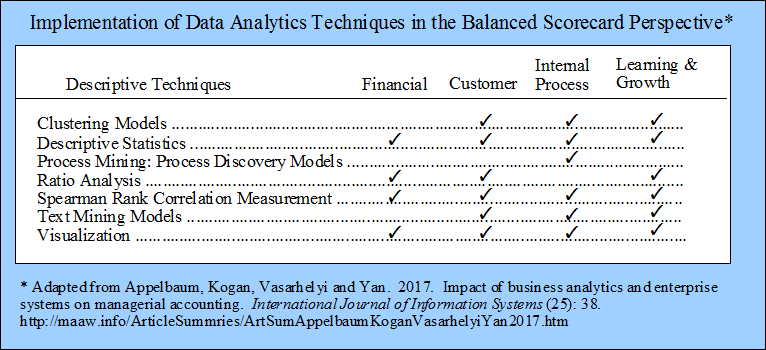

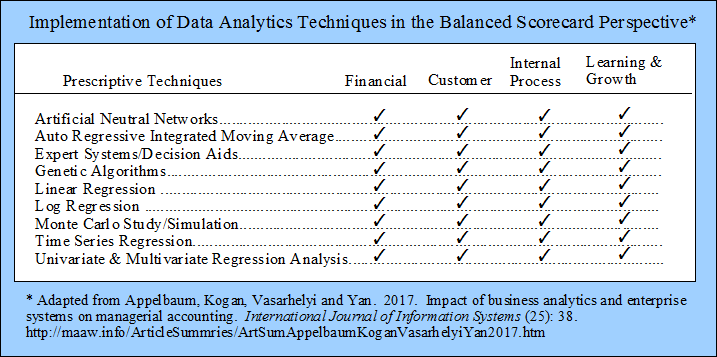
Critical Success Factors for the Framework Implementation
To be successful, the management accounting data analytics framework must become a component of a holistic enterprise-wide business intelligence system as indicated in the illustration below.
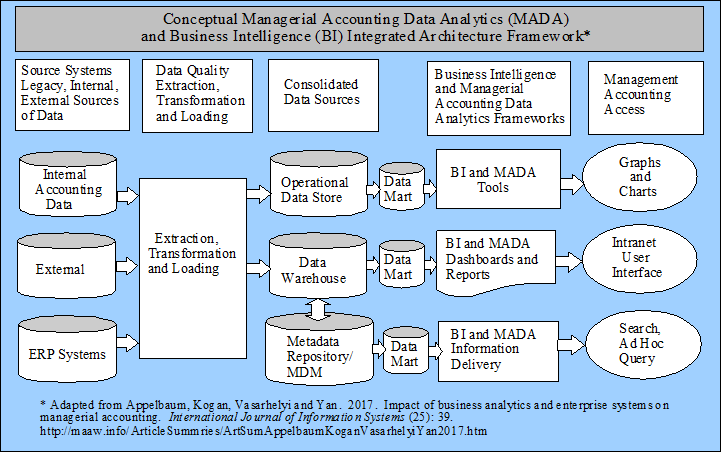
Critical success factors for business intelligence include:
Organization - Committed management support and sponsorship,
Organization - A clear vision and well-established business case,
Process - Business-Centric championship and balanced project team composition,
Process - Business-driven and iterative development approach,
Process - User-oriented change management,
Technology - Business-driven, scalable and flexible technical framework,
Technology - Sustainable data quality and integrity.
The most important factors for management accounting are business driven, scalable, flexible technical framework, and sustainable data quality and integrity. Data needs to be extracted, transformed, and loaded before it can be stored and analyzed. Software vendors (e.g., SAP, Oracle, IBM, and Microsoft) have tools and applications for this purpose. Big data requires preparation before it can be analyzed. Software applications are also available to examine the data for internal and external validity, accuracy, timeliness, completeness, and consistency. Business intelligence tools to support management accounting include the following:
Data consolidation:
Integration of internal and external data,
Simplified extraction, transformation and loading of data, and
Deletion of unwanted and unrelated data.
Data quality:
Sanitize and prepare data to improve overall accuracy.
Reporting:
User defined and standard reports generated at any level, and
Personalized reports for various levels of management.
Forecasting and modeling:
Supports analytics used in predictive and prescriptive analysis involving
historical and real-time data,
qualitative or quantitative.
Tracking of real-time data:
Monitor current progress with defined project objectives/KPIs, and
Prioritize scarce system resources.
Data visualization:
Interactive reports and graphics, possibly with real time updates, and
Scorecards and dashboards.
Data analysis:
What-if,
Sensitivity/optimization,
Goal
seeking/goal supporting, and
Descriptive analysis.
Mobility:
Portability to multiple devices and formats.
Rapid insight:
Drill down features that enable many layers of analysis, and
Dashboards that are interactive and can monitor trends and outcomes.
Report delivery and share-ability:
Deliver reports in common formats such as Microsoft Office, and
Email reports in different formats.
Ready to use applications:
Pre-built meta-data with mapping defined considering performance and
security needs,
Pre-built
reports and dashboards to support management.
Language support:
Multiple language support.
Conclusion
The theoretical managerial accounting data analytics framework (MADA) described in this paper is presented as a way for management accountants to take advantage of new developments in enterprise systems to utilize descriptive, predictive, and prescriptive analytics to measure corporate performance from the balanced scorecard perspectives, i.e., financial, customer, internal process, and learning and growth. However, there are challenges for MADA integration that include how the framework could be tested, when, where, and under what circumstances certain analytics should be applied, and the current absence of analytical skills and knowledge needed by management accountants to apply the framework.
__________________________________________________
Related summaries:
Appelbaum, D., A. Kogan and M. A. Vasarhelyi. 2017. An introduction to data analysis for auditors and accountants. The CPA Journal (February): 32-37. (Summary).
Davenport, T. H. 1998. Putting the enterprise into the enterprise system. Harvard Business Review (July-August): 121-131. (Summary).
Martin, J. R. Not dated. Balanced scorecard concepts. Management And Accounting Web. Balanced Scorecard Summary
Martin, J. R. Not dated. What is data mining? Management And Accounting Web. Data Mining
Roberts-Witt, S. L. 2002. Data mining: What lies beneath? Finding patterns in customer behavior can deliver profitable insights into your business. PC Magazine (November, 19): iBiz 1-6. (Summary).
Tschakert, N., J. Kokina, S. Kozlowski and M. Vasarhelyi. 2017. How business schools can integrate data analytics into the accounting curriculum. The CPA Journal (September): 10-12. (Summary).
Williams, S. 2011. 5 Barriers to BI success and how to overcome them. Strategic Finance (July): 26-33. (Note).